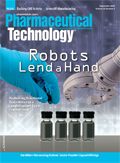Publication
Article
Pharmaceutical Technology
It's Easy Being Green
Author(s):
An outstanding new book reviews alternative solvents with an eye to sustainable pharmaceutical processes.
Alternative solvents offer many processing advantages for the high value-added chemicals in the pharmaceutical industry. And for an industry working hard to be environmentally benign, Alternative Solvents for Green Chemistry by Francesca Kerton is an ideal primer. This book does an excellent job of reviewing chemistry in a wide range of alternative solvents, and the author emphasizes how the solvents are green and how they might be applied in the pharmaceutical industry.

Alternative Solvents for Green Chemistry, Francesca M. Kerton, Royal Society of Chemistry, London, 2009, 240 pp., ISBN: 978-0-85404-163-3
Furthermore, Kerton stresses that each solvent (or group of solvents) has its own group of researchers who often see their solvent alone as the panacea for all problems. The challenge for readers, and for users of these solvents, is to understand that all are really niche solvents—they are wonderful in selected applications. Industry personnel must look beyond the chemistry and examine integrated processes of extractions, reactions, separations, and purifications. But the true key is comparing a range of alternative solvents with each other and with conventional methods to determine not only which is greener, but also which is sufficiently cost-effective to be attractive to industry.
The beginning of the book sets the stage by describing the need for alternative chemistry. The first chapter surveys relative measurements of "green-ness," including E-factors and life-cycle analysis. After giving examples of solvent-free chemistry, Kerton discusses the greenest solvent: water. This section's topics range from biphasic reactions such as phase-transfer catalysis to an excellent description of the unique properties and processing opportunities in nearcritical water.
Next is an admirable chapter about supercritical fluids, supercritical carbon dioxide and supercritical water in particular. The former is most applicable to pharmaceutical problems in extractions, reactions, and modifying materials. This chapter has an excellent discussion of both the advantages and the limitations of these fluids.
The next two chapters cover solvents from renewable sources and ionic liquids. The former certainly belong in any book on this topic, and pharmaceutical readers will probably find less new information in this chapter than they will in the other chapters. Ionic liquids offer more potential interest, but distinct hurdles remain, including the difficulties of separations and purifications after reactions. Kerton appropriately includes a chapter about fluorous solvents, and the work performed with these agents needs to be represented here. But the potential of fluorous solvents has nearly been exhausted, and other alternative solvents may lead to more pharmaceutical applications in the future. The chapter about liquid polymers is most appropriate here because the physical and chemical properties of nontoxic, food-acceptable poly(ethylene glycols) offer tremendous opportunities for this industry.
Tunable solvents undergo a large change in properties if one of their variables experiences a small change. Supercritical fluids are tunable solvents; a small change in pressure, for example, causes a big change in their density, which in turn results in an enormous change in solubility. Nearcritical water is also a tunable solvent. In one chapter, a third set of tunable solvents, gas-expanded liquids, is discussed. The chapter describes excellent pharmaceutical applications for gas-expanded liquids, such as various crystallization processes where carbon dioxide is an antisolvent, and explains work coupling bioreactions with product purification and enzyme recycling and reuse.
Switchable solvents respond to an impetus (e.g., light, heat, or pH) by undergoing a step change in properties. An example is a reversible ionic liquid, the charge of which can be turned "on" and "off." This is a new and active area that will probably result in great pharmaceutical applications in the future. Unfortunately, the majority of the best applications of alternative solvents are proprietary, but the last chapter gives a few limited case studies of available applications.
An unusual characteristic of the book is that the author uses many examples and references from the United Kingdom. In the current reviewer's opinion, a significantly greater amount of excellent work in alternative solvents is being done in North America. All in all, Alternative Solvents for Green Chemistry is an outstanding book, and this reviewer recommends it highly.
Charles A. Eckert is an institute professor of chemical and biomolecular engineering at the Georgia Institute of Technology, tel. 404.894.7070, fax 404.894.9085, cae@gatech.edu
Newsletter
Get the essential updates shaping the future of pharma manufacturing and compliance—subscribe today to Pharmaceutical Technology and never miss a breakthrough.






